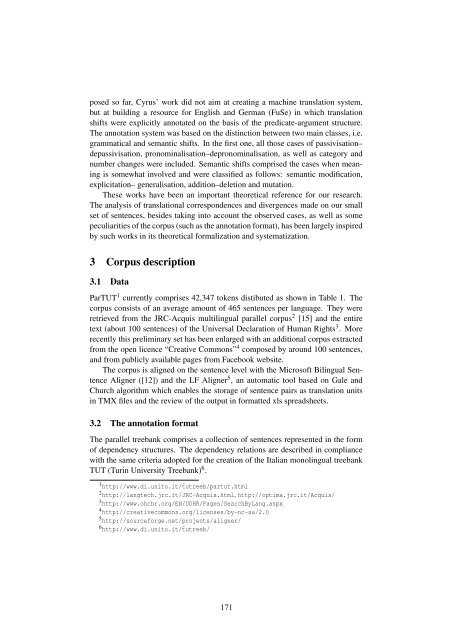A Treebank-based Investigation of IPP-triggering Verbs in Dutch
A Treebank-based Investigation of IPP-triggering Verbs in Dutch
A Treebank-based Investigation of IPP-triggering Verbs in Dutch
You also want an ePaper? Increase the reach of your titles
YUMPU automatically turns print PDFs into web optimized ePapers that Google loves.
posed so far, Cyrus’ work did not aim at creat<strong>in</strong>g a mach<strong>in</strong>e translation system,<br />
but at build<strong>in</strong>g a resource for English and German (FuSe) <strong>in</strong> which translation<br />
shifts were explicitly annotated on the basis <strong>of</strong> the predicate-argument structure.<br />
The annotation system was <strong>based</strong> on the dist<strong>in</strong>ction between two ma<strong>in</strong> classes, i.e.<br />
grammatical and semantic shifts. In the first one, all those cases <strong>of</strong> passivisation–<br />
depassivisation, pronom<strong>in</strong>alisation–depronom<strong>in</strong>alisation, as well as category and<br />
number changes were <strong>in</strong>cluded. Semantic shifts comprised the cases when mean<strong>in</strong>g<br />
is somewhat <strong>in</strong>volved and were classified as follows: semantic modification,<br />
explicitation– generalisation, addition–deletion and mutation.<br />
These works have been an important theoretical reference for our research.<br />
The analysis <strong>of</strong> translational correspondences and divergences made on our small<br />
set <strong>of</strong> sentences, besides tak<strong>in</strong>g <strong>in</strong>to account the observed cases, as well as some<br />
peculiarities <strong>of</strong> the corpus (such as the annotation format), has been largely <strong>in</strong>spired<br />
by such works <strong>in</strong> its theoretical formalization and systematization.<br />
3 Corpus description<br />
3.1 Data<br />
ParTUT 1 currently comprises 42,347 tokens distibuted as shown <strong>in</strong> Table 1. The<br />
corpus consists <strong>of</strong> an average amount <strong>of</strong> 465 sentences per language. They were<br />
retrieved from the JRC-Acquis multil<strong>in</strong>gual parallel corpus 2 [15] and the entire<br />
text (about 100 sentences) <strong>of</strong> the Universal Declaration <strong>of</strong> Human Rights 3 . More<br />
recently this prelim<strong>in</strong>ary set has been enlarged with an additional corpus extracted<br />
from the open licence “Creative Commons” 4 composed by around 100 sentences,<br />
and from publicly available pages from Facebook website.<br />
The corpus is aligned on the sentence level with the Micros<strong>of</strong>t Bil<strong>in</strong>gual Sentence<br />
Aligner ([12]) and the LF Aligner 5 , an automatic tool <strong>based</strong> on Gale and<br />
Church algorithm which enables the storage <strong>of</strong> sentence pairs as translation units<br />
<strong>in</strong> TMX files and the review <strong>of</strong> the output <strong>in</strong> formatted xls spreadsheets.<br />
3.2 The annotation format<br />
The parallel treebank comprises a collection <strong>of</strong> sentences represented <strong>in</strong> the form<br />
<strong>of</strong> dependency structures. The dependency relations are described <strong>in</strong> compliance<br />
with the same criteria adopted for the creation <strong>of</strong> the Italian monol<strong>in</strong>gual treebank<br />
TUT (Tur<strong>in</strong> University <strong>Treebank</strong>) 6 .<br />
1 http://www.di.unito.it/˜tutreeb/partut.html<br />
2 http://langtech.jrc.it/JRC-Acquis.html, http://optima.jrc.it/Acquis/<br />
3 http://www.ohchr.org/EN/UDHR/Pages/SearchByLang.aspx<br />
4 http://creativecommons.org/licenses/by-nc-sa/2.0<br />
5 http://sourceforge.net/projects/aligner/<br />
6 http://www.di.unito.it/˜tutreeb/<br />
171
















